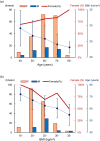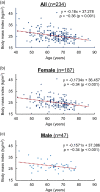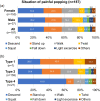Epidemiological features of acute medial meniscus posterior root tears
- PMID: 37329453
- PMCID: PMC10522759
- DOI: 10.1007/s00264-023-05848-0
Epidemiological features of acute medial meniscus posterior root tears
Abstract
Purpose: Untreated or overlooked medial meniscus posterior root tears (MMPRTs) induce sequential knee joint degradation. We evaluated epidemiological features of acute MMPRT for its early detection and accurate diagnosis.
Methods: Among 330 MMPRT patients from 2018 to 2020, those who underwent arthroscopic pullout repairs were enrolled. Patients who underwent non-operative treatment or knee arthroplasty, those with a cruciate ligament-deficient knee or advanced osteoarthritis of the knee, and those with insufficient data were excluded. Finally, we retrospectively evaluated data from 234 MMPRTs (female: 79.9%, complete tears: 92.7%, mean age: 65 years). Welch's t-test and Chi-squared test were used for pairwise comparisons. Spearman's rank correlation analysis was performed between age at surgery and body mass index (BMI). Multivariable logistic regression analysis with stepwise backward elimination was applied to the values as risk factors for painful popping events.
Results: In both sexes, there were significant differences in height, weight, and BMI. In all patients, there was a significant negative correlation between BMI and age (ρ = - 0.36, p < 0.001). The BMI cutoff value of 27.7 kg/m2 had a 79.2% sensitivity and a 76.9% specificity for detecting MMPRT patients aged < 50 years. A painful popping event was confirmed in 187 knees (79.9%), and the frequency was significantly reduced in partial tears as compared to complete tears (odds ratio: 0.080, p < 0.001).
Conclusion: Higher BMI was associated with a significantly younger age of MMPRT onset. Partial MMPRTs had a low frequency of painful popping events (43.8%).
Keywords: Body mass index; Medial meniscus; Painful popping; Posterior root tear; Pullout repair.
© 2023. The Author(s).
Conflict of interest statement
The authors declare that they have no conflict of interest.
Figures





Similar articles
-
Medial knee osteoarthritis precedes medial meniscal posterior root tear with an event of painful popping.Orthop Traumatol Surg Res. 2018 Nov;104(7):1009-1015. doi: 10.1016/j.otsr.2018.07.010. Epub 2018 Aug 11. Orthop Traumatol Surg Res. 2018. PMID: 30107275
-
Clinical outcomes of medial meniscus posterior root repair: A midterm follow-up study.Knee. 2022 Oct;38:141-147. doi: 10.1016/j.knee.2022.08.010. Epub 2022 Sep 1. Knee. 2022. PMID: 36058121
-
Meniscus extrusion is a predisposing factor for determining arthroscopic treatments in partial medial meniscus posterior root tears.Knee Surg Relat Res. 2023 Mar 14;35(1):8. doi: 10.1186/s43019-023-00182-6. Knee Surg Relat Res. 2023. PMID: 36918982 Free PMC article.
-
Investigating the Chronology of Meniscus Root Tears: Do Medial Meniscus Posterior Root Tears Cause Extrusion or the Other Way Around?Orthop J Sports Med. 2020 Nov 4;8(11):2325967120961368. doi: 10.1177/2325967120961368. eCollection 2020 Nov. Orthop J Sports Med. 2020. PMID: 33209944 Free PMC article.
-
Comparison of Long-term Radiographic Outcomes and Rate and Time for Conversion to Total Knee Arthroplasty Between Repair and Meniscectomy for Medial Meniscus Posterior Root Tears: A Systematic Review and Meta-analysis.Am J Sports Med. 2022 Jun;50(7):2023-2031. doi: 10.1177/03635465211017514. Epub 2021 Jul 12. Am J Sports Med. 2022. PMID: 34251898
Cited by
-
Longitudinal changes in medial meniscus extrusion and clinical outcomes following pullout repair for medial meniscus posterior root tears: a 3-year evaluation.Eur J Orthop Surg Traumatol. 2024 May;34(4):2021-2029. doi: 10.1007/s00590-024-03889-8. Epub 2024 Mar 22. Eur J Orthop Surg Traumatol. 2024. PMID: 38517526 Free PMC article.
-
Clinical outcomes following medial meniscus posterior root repairs: A minimum of 5-year follow-up study.J Exp Orthop. 2025 May 7;12(2):e70262. doi: 10.1002/jeo2.70262. eCollection 2025 Apr. J Exp Orthop. 2025. PMID: 40337670 Free PMC article.
-
Biomechanical Assessment and Clinical Outcomes in Meniscal Root Tears Management.J Orthop Case Rep. 2025 Jul;15(7):306-311. doi: 10.13107/jocr.2025.v15.i07.5858. J Orthop Case Rep. 2025. PMID: 40635915 Free PMC article.
-
The use of lateral wedge insoles delays osteoarthritis progression and improves clinical outcomes in medial meniscus posterior root repair.J Exp Orthop. 2025 Jan 20;12(1):e70141. doi: 10.1002/jeo2.70141. eCollection 2025 Jan. J Exp Orthop. 2025. PMID: 39839858 Free PMC article.
-
Reconstruction of medial meniscus posterior portion deficiency in pigs with an autologous patellar tendon graft: an experimental study.J Orthop Surg Res. 2024 Apr 4;19(1):225. doi: 10.1186/s13018-024-04684-1. J Orthop Surg Res. 2024. PMID: 38576008 Free PMC article.
References
LinkOut - more resources
Full Text Sources

